Explore India’s Rich Pottery Tradition with 8 Stunning Forms You Should Know About
Making pieces for both utility and decoration, the Indian pottery tradition has been a symbol of our ethnic diversity. Here's a list of eight unique pottery crafts from around India.
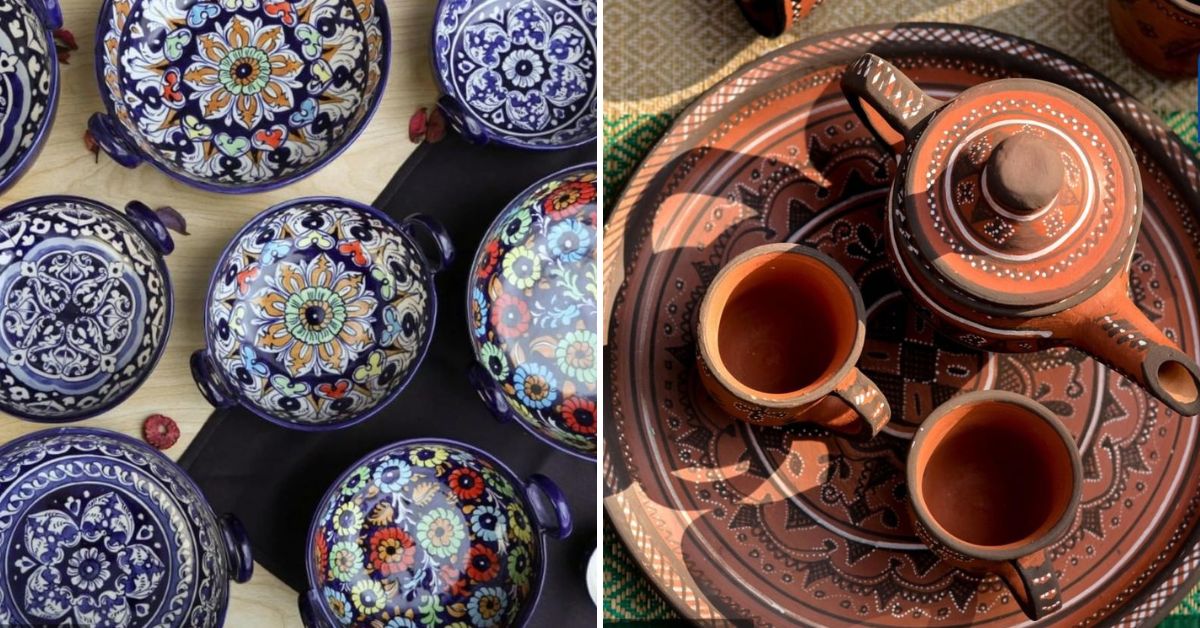
Did you know that every region in India has its own style of pottery? With unique designs and handicrafts, serving the purpose of both utility and decoration, they are often an important source of income for several artisans and are symbols of tradition and ethnicity.
Over the centuries, pottery has continued to evolve both as a craft as well as an art.
So, here’s a look at some of the famous pottery traditions that have been practised across India:
1. Jaipur Blue Pottery, Rajasthan
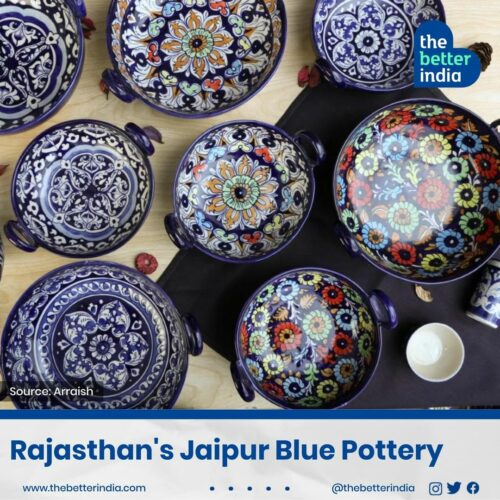
Widely recognised as a traditional craft of Jaipur, the blue pottery has its origins derived from the Turko-Persian style.
The name blue pottery was derived from the attractive cobalt blue dye used to colour the pottery. It is made using Egyptian paste and dough obtained by blending quartz stone powder, powdered glass, Multani Mitti, borax, gum and water. It does not use clay and is glazed and low fired at a very low temperature making them fragile and brittle.
The range of products is mostly decorative like vases, coasters, bowls, boxes for trinkets and so on. These pottery items are mostly decorated with animal and bird motifs.
The colour palette is always restricted to blue derived from the cobalt oxide, green from the copper oxide and white, though other non-conventional colours, such as yellow and brown are sometimes included.
2. Khurja Pottery, Uttar Pradesh
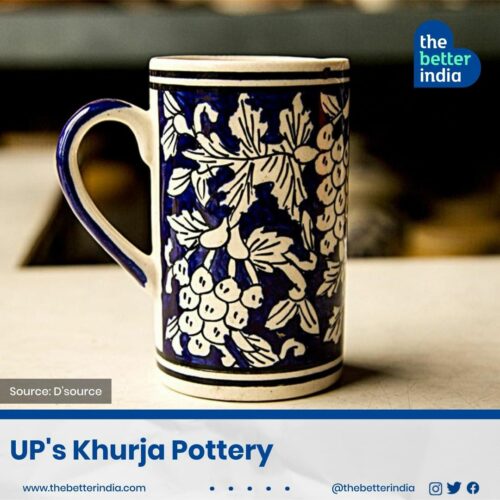
The Khurja pottery, a traditional pottery work from Khurja in the Bulandshahr district of Uttar Pradesh, is believed to have been around for over 500 years. Colourful and elegant, the Khurja pottery’s history is alleged to have begun the time when Afghan King Timur’s accompanied Egyptian and Syrian potters during his campaign in the Khurja region over five centuries ago.
This traditional pottery known for its beautiful patterns and timeless appeal is characterised by exotic floral patterns which are painted in soothing shades of blue and brown on an off-white background. Also, a thick slip is used to raise some motifs to create a three-dimensional effect. Over time, more colours have been included like warm orange and light red glazes.
3. Khavda Pottery, Gujarat
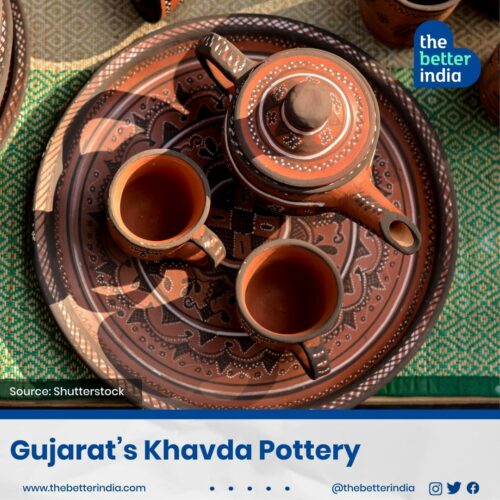
The art of Khavda pottery is believed to have begun during the Indus Valley Civilisation, in the region of present-day Kutch. Khavda—a small village in Bhuj, Gujarat—craftsmen have been making earthen pots for generations, crafting a wide variety of vessels, such as matka for water storage, plates, diyas, boxes, ketli, and kulhada to keep buttermilk and more.
The Khavda potters only use the mud from a lake area near the village, known as ‘Rann ka mitti’. The soft clay is then used to shape a pot using a potter’s wheel and dried. It is the women of the pottery community who decorate each piece using red, black, and white clay-based paints with distinct community-specific designs.
Later, the pot is cleaned, sun-dried and then baked in a furnace, after which the vessels are coated with a thin geru (red colour), a type of soil (ocher/umber).
4. Andretta Pottery, Himachal
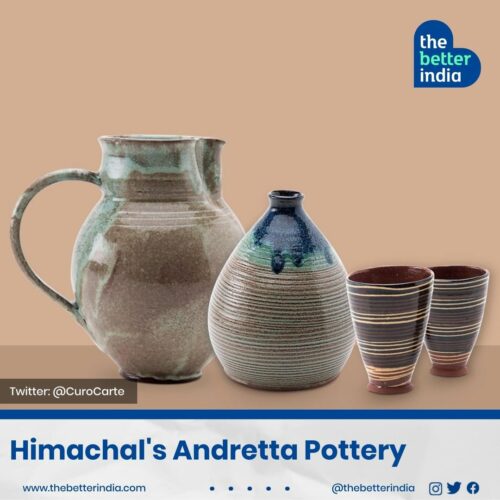
Andretta is a small artist village located near Palampur in the Kangra District of Himachal Pradesh, which was established by an Irish theatre artist and environmentalist called Norah Richards, who lived there during the partition.
In 1983, the son of the famous potter Sardar Gurcharan Singh, Mini set up Andretta Pottery and Craft Society in Himachal.
They make products majorly for tableware utility, like cups, bowls, plates and so on at the studio. All made of natural terracotta, even the glazes used are food-friendly ones. They also use slip trailing or designing methods where diluted clay is used to make designs on the surfaces. The designs and patterns they create are derived from the rangoli patterns of Kangra, Himachal Pradesh.
5. Bankura Pottery, West Bengal
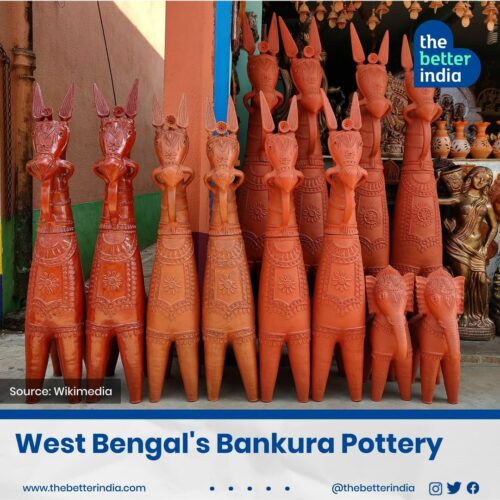
The Kumbhakar potters of Panchmura village in the Bankura district of West Bengal are known for crafting their terracotta products. For centuries together the artisans of this area have developed this art. But they are particularly known for making the Bankura horse, which has been internationally commended for its elegance and unique charm.
Originally used for village rituals, the Bankura horse now is adorned as a decorative piece across the world as well as a symbol of Indian folk art and is even the official crest motif of the All India Handicrafts Board.
Panchmura, Rajagram, Sonamukhi and Hamirpur in the Bankura district are the places where the terracotta horses and elephants are mainly produced. Though each of these places has its own distinct local style, the Panchmura-style of pottery is considered the best and the finest of all the four types.
6. Longpi Pottery, Manipur
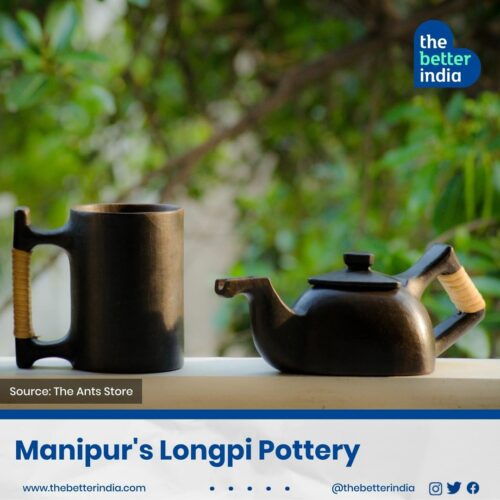
Longpi is a general reference to two villages namely Longpi Kajui and Longpi Khullen in the Ukhrul district of Manipur. The name ‘Longpi’ means ‘group lodge’ in the Tangkhul dialect.
For ages, Longpi has been famous for its old pottery making, locally called Longpi Ham. It is known that Longi Ham used to be the main cooking utensils among Tangkhuls before the aluminium pots.
Owing to its intricate designs and the technology used to produce them, the Longpi pottery has also gained prominence in the international markets.
This traditional pottery is unique since the artisans don’t use the potters’ wheel and are made from a mixed paste of ground black serpentinite stone and a special brown clay. It has been claimed by the locals that the clay is native to only Longpi village.
There is no use of chemicals or machines involved in the making of this pottery. Hence they’re considered very hygienic and are believed to have several medicinal values.
7. Bidriware, Karnataka

Bidriware is an art of metal handicrafts that originated during the 14th century in Karnataka, during the rule of the Bahamani sultans. The name ‘Bidriware’ originated from the region where it is mostly practised – Bidar in Karnataka.
This art form was believed to have initially been practised in Persia and it was brought to India by the followers of Sufi Khwaja Moinuddin Hasan Chisti. Thus Bidriware was developed as an art form having Turkish, Persian and Arabic influences.
The artisans use a blend of zinc, copper and silver to develop unique artefacts and products. It is a family legacy that has been taught and handed over to generations as time passed in Bidar.
Shiny and lustrous handcrafted products are considered a rich symbol of wealth and decor.
8. Molela Murtikala, Rajasthan
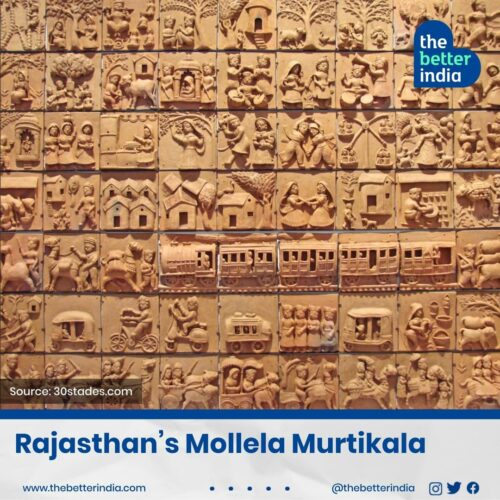
Mollela Murtikala is a clay craft of making murtis or idols of gods with terracotta, practised in the Molela village of Rajasthan.
Like most crafts, Murtikala has been passed from generation to generation, through the sons of the family. While the murtis were originally standing idols of local deities and various forms of Lord Vishnu, today they are often mounted on tiles or plaques and are hung from the walls of temples and homes.
These murtis can be multicoloured or can have a terracotta hue, as can be seen in various temples in Rajasthan and Gujarat. Also, groups of the tribal communities from Gujarat and Madhya Pradesh visit Mollela every year to buy the terracotta plaques. It is ritualistic, as they’re accompanied by a priest, and they usually focus on acquiring plaques depicting the deities Devnarayan and Nagaraja.
The potters prefer using the gentle winter sun to dry the clay, and apart from meeting religious demands, also mould scenes depicting the scenery around them.
Sources:
Himachal’s pot secret – it’s not what you think by Times of India, published on 10 January 2017.
Molela: Rajasthan’s terracotta plaque art patronised by Bhil, Mina & Garasiya tribal communities.
Bankura horses & terracotta handicrafts of Panchmura, West Bengal.
Govt. of Manipur.
Edited by Yoshita Rao

Similar Story
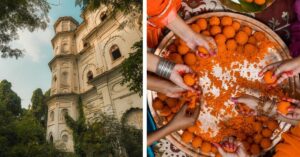
Beyond Bara Imambara: Heritage Photographer Captures Lucknow’s Hidden History
Maroof Umar loves a good story. Whether it is documenting the last calligraphy artist of Lucknow or finding home chefs who cook the best sheer khurma, here’s how he gives the city’s history a fun spin.
Read more >
If you found our stories insightful, informative, or even just enjoyable, we invite you to consider making a voluntary payment to support the work we do at The Better India. Your contribution helps us continue producing quality content that educates, inspires, and drives positive change.
Choose one of the payment options below for your contribution-
By paying for the stories you value, you directly contribute to sustaining our efforts focused on making a difference in the world. Together, let's ensure that impactful stories continue to be told and shared, enriching lives and communities alike.
Thank you for your support. Here are some frequently asked questions you might find helpful to know why you are contributing?


This story made me
-
97
-
121
-
89
-
167












